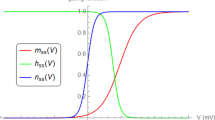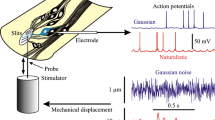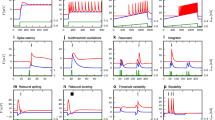Abstract.
The mechanisms underlying the diverse responses to step current stimuli of models [Edman et al. (1987) J Physiol (Lond) 384: 649–669] of lobster slowly adapting stretch receptor organs (SAO) and fast-adapting stretch receptor organs (FAO) are analyzed. In response to a step current, the models display three distinct types of firing reflecting the level of adaptation to the stimulation. Low-amplitude currents evoke transient firing containing one to several action potentials before the system stabilizes to a resting state. Conversely, high-amplitude stimulations induce a high frequency transient burst that can last several seconds before the model returns to its quiescent state. In the SAO model, the transition between the two regimes is characterized by a sustained pacemaker firing at an intermediate stimulation amplitude. The FAO model does not exhibit such a maintained firing; rather, the duration of the transient firing increases at first with the stimulus intensity, goes through a maximum and then decreases at larger intensities. Both models comprise seven variables representing the membrane potential, the sodium fast activation, fast inactivation, slow inactivation, the potassium fast activation, slow inactivation gating variables, and the intra cellular sodium concentration. To elucidate the mechanisms of the firing adaptations, the seven-variable model for the lobster stretch receptor neuron is first reduced to a three-dimensional system by regrouping variables with similar time scales. More precisely, we substituted the membrane potential V for the sodium fast activation equivalent potential V m , the potassium fast inactivation V n for the sodium fast inactivation V h , and the sodium slow inactivation V l for the potassium slow inactivation V r . Comparison of the responses of the reduced models to those of the original models revealed that the main behaviors of the system were preserved in the reduction process. We classified the different types of responses of the reduced SAO and FAO models to constant current stimulation. We analyzed the transient and stationary responses of the reduced models by constructing bifurcation diagrams representing the qualitatively distinct dynamics of the models and the transitions between them. These revealed that (1) the transient firings prior to reaching the stationary state can be accounted for by the sodium slow inactivation evolving more slowly than the other two variables, so that the changes during the transient firings reflect the bifurcations that the two-dimensional system undergoes when the sodium slow inactivation, considered as a parameter, is varied; and (2) the stationary behaviors of the models are captured by the standard bifurcations of a two-dimensional system formed by the membrane potential and the potassium fast inactivation. We found that each type of firing and the transitions between them is due to the interplay between essentially three variables: two fast ones accounting for the action potential generation and the post-discharge refractoriness, and a third slow one representing the adaptation.
Similar content being viewed by others
Author information
Authors and Affiliations
Additional information
Received: 28 February 2000 / Accepted in revised form: 4 October 2000
Rights and permissions
About this article
Cite this article
Takeuchi, E., Yamanobe, T., Pakdaman, K. et al. Analysis of models for crustacean stretch receptors. Biol Cybern 84, 349–363 (2001). https://doi.org/10.1007/PL00007981
Issue Date:
DOI: https://doi.org/10.1007/PL00007981




